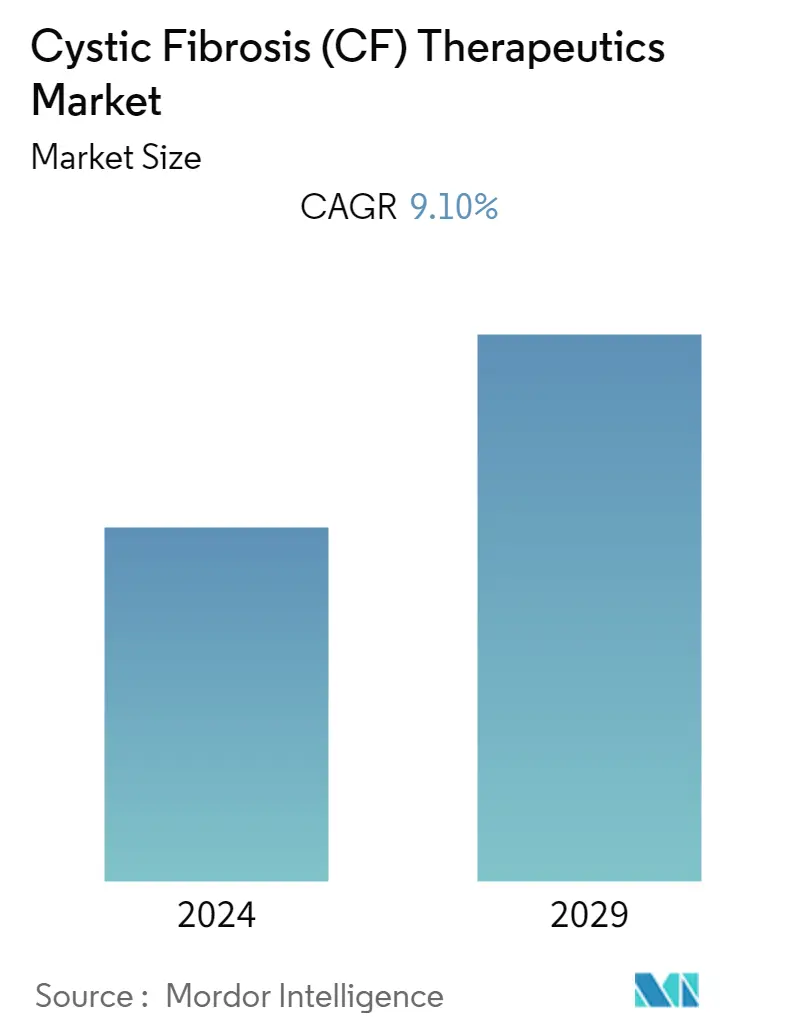Market Size of Cystic Fibrosis (CF) Therapeutics Industry

| Study Period | 2019 - 2029 |
| Base Year For Estimation | 2023 |
| Forecast Data Period | 2024 - 2029 |
| CAGR | 9.10 % |
| Fastest Growing Market | Asia Pacific |
| Largest Market | North America |
Major Players
*Disclaimer: Major Players sorted in no particular order |
Cystic Fibrosis Therapeutics Market Analysis
The cystic fibrosis therapeutics market is anticipated to register a CAGR of nearly 9.1% during the forecast period. The increasing prevalence of cystic fibrosis (CF), coupled with the rising treatment rate, is one of the key factors expected to bode well for the market growth for these therapeutics. Moreover, a rising number of initiatives undertaken by nonprofit organizations, an increase in R&D funding by both private and public organizations, and supportive government legislation are some of the crucial factors expected to drive the market in the coming few years.
According to the data published by the Cystic Fibrosis Foundation, the incidence of these hereditary disorders is constantly growing. In 2019, there were more than 70,000 patients are living with cystic fibrosis. Increasing year-on-year growth in the number of patients further results in surging demand for efficient and effective CF therapeutics.
The rising number of potential clinical pipeline candidates is one of the key factors expected to propel the market growth. Moreover, upsurge in the number of clinical trials to expand its target patient base with the existing drug portfolio is also amongst some of the drivers of this market. Growing R&D activities are expected to propel market growth. Some of the pipelined drugs are Symdeko (tezacaftor + ivacaftor), VX-561, ELX-02 and ABBV-3067.
The presence of various nonprofit organizations, such as Cystic Fibrosis Worldwide, Cystic Fibrosis Foundation, Cystic Fibrosis Canada, South African Cystic Fibrosis Trust, and South African Cystic Fibrosis Association, which are consistently involved in the activities related to CF is also one of the pivotal factors that can be accounted for surging demand. These organizations are investing huge amount of funds to find various therapeutics for CF and to support the research and developmental activities by prominent players. However, high cost of the treatment may restrain the growth of the market.
Cystic Fibrosis Therapeutics Industry Segmentation
Cystic fibrosis is a rare, life-shortening genetic disease caused by mutations of the cystic fibrosis transmembrane conductance regulator - or CFTR - gene. This gene is located in chromosome number seven and is responsible for the regulation of sweat, mucus, and body secretions. There are around 2000 identified mutations in the gene, 127 of which are currently known to cause CF. Cystic fibrosis therapeutics market is segmented by drug class, by route of administration and geography.
| By Drug Class | |
| Pancreatic Enzyme Supplements | |
| Mucolytics | |
| Bronchodilators | |
| CFTR Modulators |
| By Route of Administration | |
| Oral Drugs | |
| Inhaled Drugs |
| Geography | ||||||||
| ||||||||
| ||||||||
| ||||||||
| ||||||||
| South America | ||||||||
| Brazil | ||||||||
| Argentina | ||||||||
| Rest of South America |
Cystic Fibrosis (CF) Therapeutics Market Size Summary
The cystic fibrosis therapeutics market is poised for significant growth, driven by the increasing prevalence of cystic fibrosis and the rising rate of treatments. Key factors contributing to this expansion include heightened research and development activities, substantial funding from both private and public sectors, and supportive government policies. Nonprofit organizations play a crucial role by investing in research and development, further propelling market demand. The market is characterized by a growing number of clinical pipeline candidates and trials, which are expected to broaden the patient base and enhance the effectiveness of existing drug portfolios. Despite the high cost of treatment posing a potential challenge, the market is expected to thrive due to the continuous development of new therapeutics and combination therapies.
CFTR modulators are anticipated to dominate the market, supported by new product launches and their ability to address the underlying causes of cystic fibrosis. The segment is experiencing a shift towards combination therapies, which offer improved patient outcomes. North America leads in market growth, bolstered by high healthcare spending, awareness, and favorable policies. The Asia-Pacific region is expected to witness the fastest growth, driven by urban lifestyle changes and increased healthcare investments. Key industry players, including AbbVie Inc., Vertex Pharmaceuticals Inc., and others, are focused on innovation and strategic investments in research and development to maintain a competitive edge. The introduction of new products, such as KALYDECO, highlights the industry's commitment to expanding treatment options and addressing the evolving needs of cystic fibrosis patients.
Cystic Fibrosis (CF) Therapeutics Market Size - Table of Contents
-
1. MARKET DYNAMICS
-
1.1 Market Overview
-
1.2 Market Drivers
-
1.2.1 Increasing Prevalence of Cystic Fibrosis
-
1.2.2 Supportive Government Legislation
-
1.2.3 Increase in Potential Clinical Pipeline Candidates
-
-
1.3 Market Restraints
-
1.3.1 Patent Expiration of Blockbuster and Generic Drugs
-
1.3.2 High Cost of Disease Treatment
-
-
1.4 Porter's Five Force Analysis
-
1.4.1 Threat of New Entrants
-
1.4.2 Bargaining Power of Buyers/Consumers
-
1.4.3 Bargaining Power of Suppliers
-
1.4.4 Threat of Substitute Products
-
1.4.5 Intensity of Competitive Rivalry
-
-
-
2. MARKET SEGMENTATION
-
2.1 By Drug Class
-
2.1.1 Pancreatic Enzyme Supplements
-
2.1.2 Mucolytics
-
2.1.3 Bronchodilators
-
2.1.4 CFTR Modulators
-
-
2.2 By Route of Administration
-
2.2.1 Oral Drugs
-
2.2.2 Inhaled Drugs
-
-
2.3 Geography
-
2.3.1 North America
-
2.3.1.1 United States
-
2.3.1.2 Canada
-
2.3.1.3 Mexico
-
-
2.3.2 Europe
-
2.3.2.1 Germany
-
2.3.2.2 United Kingdom
-
2.3.2.3 France
-
2.3.2.4 Italy
-
2.3.2.5 Spain
-
2.3.2.6 Rest of Europe
-
-
2.3.3 Asia-Pacific
-
2.3.3.1 China
-
2.3.3.2 Japan
-
2.3.3.3 India
-
2.3.3.4 Australia
-
2.3.3.5 South Korea
-
2.3.3.6 Rest of Asia-Pacific
-
-
2.3.4 Middle-East and Africa
-
2.3.4.1 GCC
-
2.3.4.2 South Africa
-
2.3.4.3 Rest of Middle-East and Africa
-
-
2.3.5 South America
-
2.3.6 Brazil
-
2.3.7 Argentina
-
2.3.8 Rest of South America
-
-
Cystic Fibrosis (CF) Therapeutics Market Size FAQs
What is the current Cystic Fibrosis (CF) Therapeutics Market size?
The Cystic Fibrosis (CF) Therapeutics Market is projected to register a CAGR of 9.10% during the forecast period (2024-2029)
Who are the key players in Cystic Fibrosis (CF) Therapeutics Market?
AbbVie Inc , Gilead Sciences, Inc, Mylan N.V, Alaxia and Vertex Pharmaceuticals Incorporated are the major companies operating in the Cystic Fibrosis (CF) Therapeutics Market.

